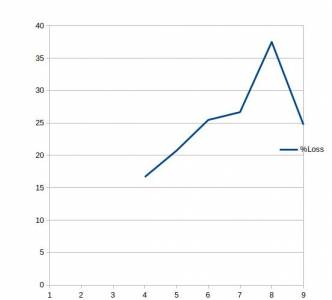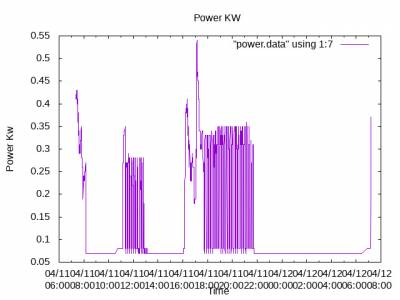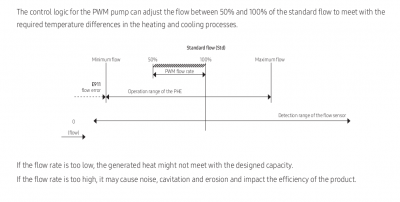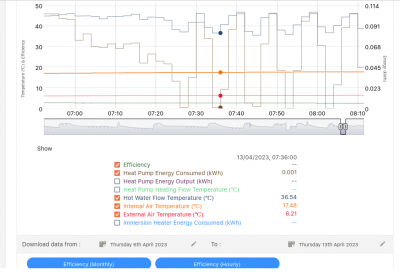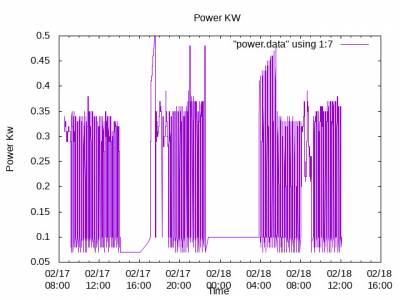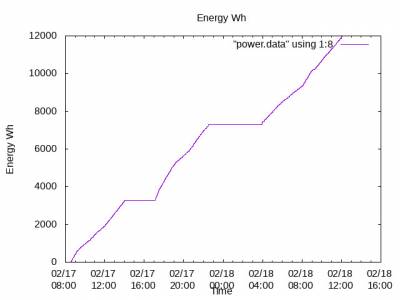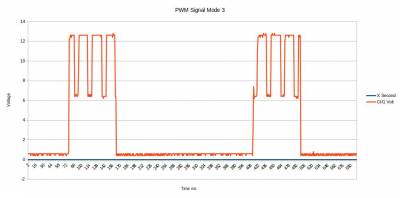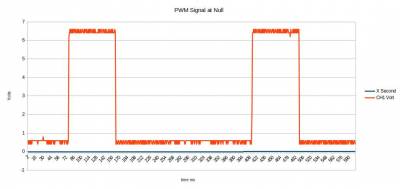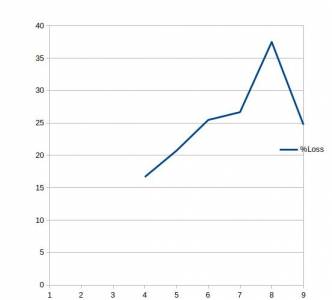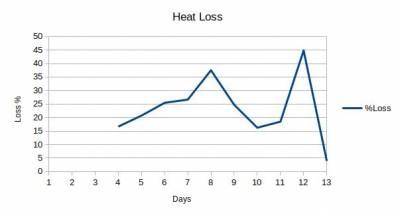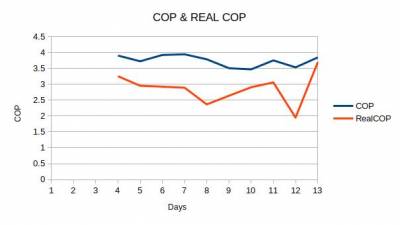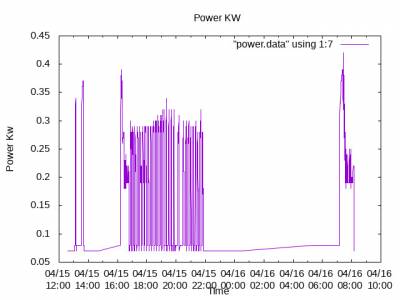@grahamh PWM Not Working
With a blushing SAMSUNG ENGINEER avoiding eye contact ,weakly trying to defend the PWM System on SAMSUNG HEAT PUMPS and your own excellent experience I have lost confidence in SAMSUNG .
I now accept that the PWM system, as implemented by SAMSUNG is mismatched to the Grundfoss PWM Motors.
However, I still have violent Short Cycling on both sides of an unwanted Heat Exchanger.
A 50 litre Volumising tank was fitted on the Heat Pump side of the Heat Exchanger removing one frequency of short-cycling.
I now have short Cycling on the Radiator side of the Heat Exchanger.
The tangle of pipes , heat exchanger and volumising tank are losing about 25% of the Energy generated by the Heat pump.
Heat losses
Should I worry about the "violent" short-cycling or wait until the motors ( plural) and the PCB relay arcs itself to oblivion?
ian
Ok so first never run the unit below 30 or even better 35c flow temp. You will get tons of cycling
Heat pumps don't work well below these temperatures. I haven't got time to explain here why but might blog on linked in about it this week. Next measure the return to the hp and return from heating. These temperatures should be the same if it's balanced . The plate is fine, will work brilliantly if it's all set up ok. It's there for a very good reason. It's not just keeping glycol out of the rads.
Don't worry too much about the cycling, it won't wear the unit out. It's designed to cope with this. The dream is to have less than 6 times a day you will never achieve this. Mine at home cycles 15 to 20 times a day. That's fine.
Concentrate on balancing primary hp flow and secondary heating flow. Get these the same and it's done.
If your installer had been listening when in training they would have been told how to do this. It's easy. As described above.
Heat pump builder
Posted by: @grahamhdont believe all the lies you are told.
I am sure you are correct. I will collect the evidence [of it not working] and send it to Samsung [not that I expect much out of that]
Their latest manual states the following (first image)
The second image shows the typical ambiguous language in the manual[s] from Samsung and could mean what you say ... fixed to either 70% or 100%.
@william1066 Latest Manual....first page?
Sorry William , what manual are you referring to here .
The NEW EHS Installation manual has nothing about this.
ian
Sorry William, I found the PWM Flow rate on page 58 of my new manual.
Many thanks also to Graham , the new version of the manual at 208 pages is infinitely better than the old version.
From page 58
" The installer is responsible to meet the exact designed flow rate ( Water Flow Rate(Std)(H/C) as stated in the applicable TDB."
What is my Designed Flow rate ...............my system was never designed!
What is a balancing valve? Would any old valve act as a balancing valve?
Posted by: @grahamhOk so first never run the unit below 30 or even better 35c flow temp. You will get tons of cycling
Heat pumps don't work well below these temperatures. I haven't got time to explain here why but might blog on linked in about it this week. Next measure the return to the hp and return from heating. These temperatures should be the same if it's balanced . The plate is fine, will work brilliantly if it's all set up ok. It's there for a very good reason. It's not just keeping glycol out of the rads.
Don't worry too much about the cycling, it won't wear the unit out. It's designed to cope with this. The dream is to have less than 6 times a day you will never achieve this. Mine at home cycles 15 to 20 times a day. That's fine.
Concentrate on balancing primary hp flow and secondary heating flow. Get these the same and it's done.
If your installer had been listening when in training they would have been told how to do this. It's easy. As described above.
@grahamh Do you mean ' less than 6 times a day' and '15 to 20 times a day' or per hour? 15 to 20 times a day does indeed seem to be nothing to worry about, but @iantelescope's cycling seems much more frequent. My 12kW Samsung occasionally starts cycling very frequently - 5 mins 30 secs on and 3 mins 30 secs off and so on. It generally happens when the ambient temperature is over 10 deg C and I presumed that the radiators were unable to get rid of the heat energy due to the lower flow temperatures and that the HP was unable to modulate low enough. However, today it was cycling with an ambient temperature of 6 deg C and flow temperature around 44 deg C. Delta T was actually quite high at 8.71 deg C shortly before it cycled off, which is the opposite of what I imagine is usually associated with short cycling at high ambient temperatures. Anybody have any ideas?
@mike-h World record for Hyper-Cycling!
Have a look at my Hyper-Cycling SAMSUNG HEAT PUMP.
I make it 94 cycles in one day!
Can anyone beat this record?
The Hyper Cycling is consuming lots and lots of Juice!
Perhaps you can appreciate why I want the PWM motor driver to work!
The SAMSUNG HEAT PUMP was delivered with an unwanted Heat Exchanger dividing the Heat Pump to Radiator loop into TWO separate loops each with separate cycling problems at different frequencies!
A 50 litre Volumising tank was fitted into the Heat Pump to Heat Exchanger loop to eliminate cycling but at an even greater consumption of juice!
The Hyper cycling is consuming around 9 KWh of energy for the 17 th February 23.
.
@mike-h PWM Signals producing E912 errors when Not in use!
I have been recording the PWM Signals presented to my GRUNDFOSS MOTORS.
When supplying Energy I get the following signal
When Not supplying energy I get the following signal....
Notice the Amplitude changes along with the curious PWM signal when supplying energy.
As ever with SAMSUNG things do not , however go entirely without Errors, E912 this time appears when Not supplying energy.
I am experimenting but may have to return to switching the Motor mains AND Modulating the PWM Signal!
Oh, SAMSUNG ,.......everything works but , there is always a BUT
ian
look i know its not what you want to hear but stop obsessing over the PWM output. Im afraid that most heat pumps dont really have a pwm function at all, they say they do in the book but the unit is not clever enough to control pump speed and inverter compressor speed. its just life. we have to move on. before we had PWM the units worked fine, they will do so now. if you have rapid cycling its not going to be fixed by altering the speed of the waiter through your unit. You have to look at the amount of heat you are rejecting from the water. this is a function of the speed of the water through the rads and the temperature they run at. there is very likely nothing wrong with your heat pump, the problem is always in the heating system itself. sort out the flow to the rads and the heat pump is suddenly fixed.
one of the reasons ive become disillusioned with the whole heat pump game is everyone blames the heat pump because an idiot put it onto a terrible heating system. If you connect a shit caravan to a nice car it becomes a terrible vehicle. its important to concentrate on the worst bit first.
Heat pump builder
Posted by: @grahamhOk so first never run the unit below 30 or even better 35c flow temp. You will get tons of cycling
Heat pumps don't work well below these temperatures.
Posted by: @grahamhthere is very likely nothing wrong with your heat pump, the problem is always in the heating system itself. sort out the flow to the rads and the heat pump is suddenly fixed.
So it's all about "supply and demand"
THE PWM
I have finally got a "hopefully working PWM Motor controlling the Motor Speed to control the Water Heat Power.
The Critical part in getting the PWM was setting the Water Flow rate until the PWM Signal was operating at the Center of it’s range.
If the rate of water flow is too great , or too small, the PWM Signal cannot control the water power.
I chose an operating power of half the 5 KW nominal power of the Heat Pump, 2.5 KW.
Since Power ( KW) = Water_Flow_rate ( M^3/sec) X Specific-heat_of water( KJ/(KgXC) X Delta _T
2.5 = Flow_rate X 4.3 X 3
Or
Flow_rate= 2.5 X 60 /(4.3 X 3) = 11.5 litres/per minute.
When the Water Flow rate was reduced to 12 lpm the following results were obtained.
And the REAL COP has improved
My Heat is however still Hyper-Cycling on the Radiator water loop
The Second PWM Motor will have to be supplied with a home made "Arduino" source.
ian
- 26 Forums
- 2,396 Topics
- 54.3 K Posts
- 358 Online
- 6,077 Members
Join Us!
Worth Watching
Latest Posts
-

RE: Fan is clipping ice build up from the front of unit.
In fairness, @toodles, I'd be more concerned if it beca...
By Majordennisbloodnok , 22 minutes ago
-

RE: Setback savings - fact or fiction?
Just as an aside, I notice your graph has come from Hom...
By Majordennisbloodnok , 28 minutes ago
-

RE: Running from backup generaor in powercut?
It seems the Microsoft minute has been usurped by the S...
By Majordennisbloodnok , 52 minutes ago
-
RE: Recommended home battery inverters + regulatory matters - help requested
That doesnt seem quite the same description as the one ...
By JamesPa , 1 hour ago
-
RE: Running my new Nibe ASHP efficiently
I'm new to the forum. Did you get a reply to this last ...
By Mike @ Camelot , 1 hour ago
-

RE: ASHP Energy Consumption: Aira 12kW heat pump
@grantmethestrength MCS requirements for DHW capacity h...
By Toodles , 2 hours ago
-
RE: New Mitsubishi Ecodan 11.2kW installation - L9 errors and maybe more
Great to hear! I just figured this out a day or tw...
By anotherdaveuk , 3 hours ago
-
RE: Help me keep the faith with my air source heat pump installation
@adamk I'm observing my own system at low temperatures ...
By dr_dongle , 8 hours ago
-

RE: Free Ecoheat Heat Pump Install
@deltona Yes older houses are problematic like that, bu...
By bontwoody , 1 day ago
-
RE: Radiator sizing sanity check
As I mentioned early on the cost of supplying and fitti...
By JamesPa , 1 day ago
-
RE: Advice for a novice on Mitsubishi Ecodan 6kW
I hadn't spotted that there were two pumps in the UFH (...
By JamesPa , 1 day ago
-
RE: Electricity price predictions
Great point, one of the key ones in my chat with Octopu...
By Batpred , 2 days ago
-

RE: New Fogstar 15.5kWh upright solution
Let me point out that there are many Chinese suppliers ...
By Transparent , 2 days ago
-

RE: Weather compensation- why you should use it
@majordennisbloodnok — The Two Ronnies Mastermind sketc...
By cathodeRay , 2 days ago
-
Just realised that this image of the cylinder cupboard ...
By Sheriff Fatman , 2 days ago
-

RE: Rodents! A word of warning for heat pump owners
Two thoughts: 1: Let's ask @david-s if Primary Pro in...
By Transparent , 2 days ago
-
RE: Solis S6-EH1P8K-L-PLUS – Why I Chose It and What I’ve Learned So Far
In the diagram below, I describe my understanding of th...
By Batpred , 2 days ago
-
I need to have a look out for it. I know IBM feeds some...
By Batpred , 2 days ago
-
-
RE: Daikin Atherma ASHP Cycling 6 Times an Hour?
Thanks for your reply. Yes that's a good idea to try a...
By John Marshall , 2 days ago

